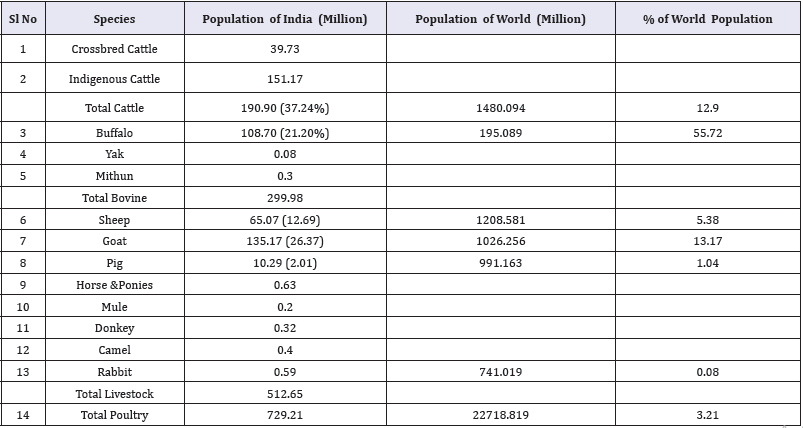- Submissions

Full Text
Approaches in Poultry, Dairy & Veterinary Sciences
Livelihood Security in India by Animal Husbandry
Das SK*
Department of Veterinary, Indian Veterinary Research Institute, India
*Corresponding author: S K Das, Department of Veterinary, Principal Scientist Training and Education Center, Indian Veterinary Research Institute, Maharashtra, India
Submission: May 22, 2018;Published: July 19, 2018

ISSN 2576-9162Volume4 Issue3
Keywords
Livestock; Poultry; Socio-economic conditions; Populations; Cattle; Buffalo; Sheep; Goat; Pig; Horses; Ponies; Mules; Donkeys; Camels; Mithun; Yak; Agriculture; Animals; Milk Products; Eggs
Opinion
India has vast resource of livestock and poultry, which play a vital role in improving the socio-economic conditions of the rural masses. India has the largest livestock populations in the world. The total livestock population consisting of cattle, buffalo, sheep, goat, pig, horses & ponies, mules, donkeys, camels, mithun, yak and rabbit in the country is 512.65 million numbers in 2012. The total livestock population has decreased by about 3.33% over the previous census. Out of total livestock in the country, 37.24 % were cattle, 21.20 % buffaloes, 12.69 % sheep, 26.37 % goats and 2.01 % pigs. All other animals such as mithun, yaks, horses, ponies, mules, donkey and camels are 0.49 % of the total livestock. As per the figures of 2012 livestock census, India has 190.90 million cattle out of which 39.73 million were crossbred. The livestock sector alone contributes nearly 25.6 % of value of output at current prices of total value of output in Agriculture sector. The overall contribution of Livestock Sector in total GDP is nearly 4.11 % at current prices during 2012 -2013 (Table 1).
Table 1: Livestock Population of India.

Source: 19th livestock census (2012)
Livestock are domesticated animals intentionally reared in an agricultural setting for want of food or fibre, or for their labour. Livestock include pigs, cattle, goats, sheep, and poultry. The type of livestock reared varies worldwide and depends on factors such as climate, consumer demand, native animals, local traditions, and land type. The livestock population shows high degree of diversity in its composition. The livestock sector produced 135.6 million tones of milk, 69.8 billion eggs, 6.00 million tones of meat and 46.5 million kg of wool in 2012- 2013.
Livestock sector provides employment to 38 million people and nearly 70 per cent of them are women. Further, dairy sector is the major source of income for an estimated 27.6 million people. Among these 65 to 70% are small, marginal farmers and land-less labour. The dairy sector supports around 15.5 million farmers through 1.65 lakh cooperative societies existing in the country. Apart from employment generated by rearing of animals, the procurement of milk and its processing also provides substantial employment.
According to FAO, the world livestock population in 2014 comprised of 1,480 million cattle, 195 million buffaloes, 1,208 million sheep, 1026 million goats and 991 million pigs. India has 55.72% of the world’s buffalo population, 12.90% of the world cattle population, 13.17% of world goat population and 5.38 % of world sheep population. It ranks first in respect of buffalo population, second in cattle and goat population, third in sheep population in the world.Total export earnings of India from livestock, poultry and related products in 2012 -2013 was Rs. 5,548.8 million US dollar, of which meat and meat products accounted for Rs. 4695.1 million US dollar (84.61 %), milk and milk products accounted for Rs. 595.8 million US dollar (10.74%), live animals 155.4 million US dollar (2.80%), egg 86.8 million US dollar (1.56 %),wool and hair 7.63 million US dollar (0.14%), hide & skin 4.32 million US dollar (0.08%) and animal fat accounted 3.89 million US dollar (0.07%).
© 2018 Das SK*. This is an open access article distributed under the terms of the Creative Commons Attribution License , which permits unrestricted use, distribution, and build upon your work non-commercially.
 a Creative Commons Attribution 4.0 International License. Based on a work at www.crimsonpublishers.com.
Best viewed in
a Creative Commons Attribution 4.0 International License. Based on a work at www.crimsonpublishers.com.
Best viewed in 







.jpg)






























 Editorial Board Registrations
Editorial Board Registrations Submit your Article
Submit your Article Refer a Friend
Refer a Friend Advertise With Us
Advertise With Us
.jpg)






.jpg)














.bmp)
.jpg)
.png)
.jpg)










.jpg)






.png)

.png)



.png)






